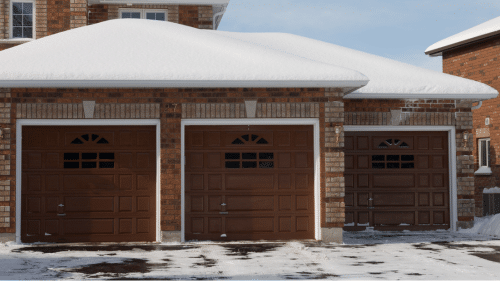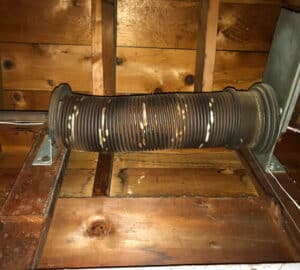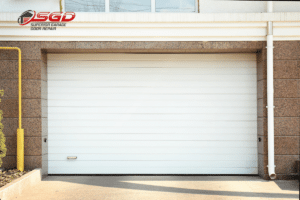In the harsh winter climate of Minneapolis, MN, maintaining your garage door is critical for ensuring safety, energy efficiency, and smooth operation. This guide offers an extensive winter maintenance checklist, tailor-made for the unique challenges faced in Minneapolis.
1.Inspecting and Adjusting Door Balance
A. Steps for Checking Door Balance
To ensure your garage door operates smoothly and lasts longer, it’s crucial to check its balance, especially before winter sets in. An unbalanced door can strain the opener and pose safety risks.
Steps to Check Balance:
- Disconnect the Opener: Start by disconnecting the automatic opener to move the door manually.
- Lift the Door Manually: Lift your garage door halfway up. A well-balanced door should stay in place, slightly rising or falling.
- Observe the Movement: If the door falls rapidly or is hard to lift, the balance is off.
- Inspect Springs: Look for signs of wear or damage in the springs, as they are crucial for balance.
B. Importance of Professional Balance Adjustment
Adjusting the balance of a garage door is not a typical DIY task. It requires technical expertise, as incorrect adjustment can lead to safety hazards. Professional technicians have the tools and knowledge to adjust tension safely and effectively, ensuring your door operates seamlessly.
C. Risks of an Unbalanced Garage Door
An unbalanced door can lead to numerous problems:
- Increased Wear: Parts wear out faster, leading to more frequent repairs.
- Safety Risks: An unbalanced door can unexpectedly fall, posing a danger to people and property.
- Energy Inefficiency: Gaps caused by poor balance can let in cold air, increasing heating costs.
2.Weather-Stripping and Insulation Evaluation
A. Inspecting Weather-Stripping for Damages
Weather-stripping is your first defense against the cold. Inspect it for cracks, gaps, and brittleness. Look along the sides, top, and bottom of the door. Replacing worn weather-stripping is a cost-effective way to enhance energy efficiency and keep your garage warm.
B. Importance of Proper Insulation
Proper insulation in your garage door is vital for maintaining temperature control and energy efficiency. It prevents heat loss, reducing energy bills and keeping your garage comfortable. Insulation also adds rigidity to the door, enhancing its durability.
C. DIY Tips for Weather-Stripping Replacement
Replacing weather-stripping is a manageable DIY project:
- Measure and Purchase: Measure your door and buy the correct size and type of weather-stripping.
- Remove Old Stripping: Carefully remove the old weather-stripping without damaging the door.
- Clean and Prep the Area: Clean the area thoroughly before applying the new stripping.
- Install: Follow the manufacturer’s instructions for installation, ensuring a snug and aligned fit.
3.Lubrication of Moving Parts
A. Choosing the Right Lubricant
The right lubricant can significantly extend the life of your garage door. Use a silicone or lithium-based lubricant, as they resist hardening in cold temperatures. Avoid WD-40, as it’s a cleaner rather than a lubricant. Apply lubricant to rollers, hinges, bearings, and springs.
B. Step-by-Step Lubrication Process
- Clean First: Remove dirt and debris from the moving parts.
- Apply Lubricant Sparingly: Over-lubrication can attract dirt. Focus on pivot points, roller bearings, and spring coils.
- Wipe Excess: After applying, wipe away excess to prevent dripping.
- Test Door: Open and close the door a few times to distribute the lubricant.
C. Common Mistakes in Garage Door Lubrication
Common lubrication errors include:
- Over-Lubrication: Leads to dirt accumulation.
- Using the Wrong Product: Causes deterioration of parts.
- Neglecting Certain Parts: Like bearings or springs, which are crucial for smooth operation.
4.Door Opener and Safety Feature Maintenance
A. Testing Door Opener’s Force Settings
Ensuring your garage door opener’s force settings are correct is vital for safety and efficiency. If the force is too high, the door might close too forcefully, posing a risk. Test by placing a 2×4 on the ground where the door closes. If it doesn’t reverse on contact, adjust the settings.
B. Checking and Aligning Safety Sensors
Misaligned safety sensors can cause your garage door to fail to close or reverse unexpectedly. Check alignment by measuring the height of each sensor from the ground and ensuring they are pointing directly at each other.
C. Importance of Battery Backup in Winters
A battery backup is essential in winter, especially in areas prone to power outages. It ensures your garage door can operate normally during a power failure, providing safety and convenience.
5. Managing Garage Condensation
A. Strategies to Reduce Moisture
High moisture levels in your garage can lead to mold and mildew growth. Improve ventilation, use a dehumidifier, and seal any gaps in doors and windows to reduce moisture.
B. Ventilation and Dehumidification Solutions
Proper ventilation is key. Consider installing vents or an exhaust fan. Dehumidifiers also play a crucial role in maintaining a dry environment, preventing condensation.
C. Long-Term Effects of Condensation on Garage Doors
Unchecked condensation can cause rusting of metal parts, warping of wooden doors, and deterioration of insulation materials. Regularly check for signs of moisture damage.
6. Spring Inspection and Care
A. Identifying Signs of Wear in Springs
Garage door springs are under high tension and wear out over time. Look for signs of wear such as uneven gaps, loose coils, or rust. If the door opens unevenly or not at all, it’s a clear sign of spring issues.
B. Safety Precautions During Inspection
Inspecting springs can be dangerous. Always disconnect the opener before inspection and never attempt to repair or replace springs yourself, as they require special tools and expertise.
C. When to Call Professionals for Spring Maintenance
If you notice significant wear or any issues with your springs, it’s time to call a professional. DIY repairs can be hazardous and may lead to further damage or injury.
7. Rust Prevention and Treatment
A. Detecting Rust Early
Early detection of rust is crucial for maintaining the integrity of your garage door. Regularly inspect all metal components, especially springs, hinges, and rollers, for any signs of rust or corrosion. Look for discoloration or flaking metal, which are early indicators.
B. Rust Removal Techniques
If you spot rust, act quickly to prevent its spread. Use a wire brush to scrub off surface rust gently. Then, apply a rust-inhibiting primer followed by paint, if necessary. For severe cases, replacing the affected parts might be the best solution.
C. Preventive Measures for Rust
Prevention is key in managing rust. Regular lubrication with the right product can protect against rust. Also, ensure good drainage around your garage to prevent standing water, which accelerates rusting.
8. Preparing Garage Interior for Winter
A. Insulation Best Practices
Proper insulation in your garage can significantly impact energy efficiency and warmth. Inspect and upgrade insulation in walls and the garage door. Weather-sealing doors and windows also prevent cold drafts.
B. Organizational Tips for Efficient Operation
A well-organized garage ensures smooth operation of the door and easy access. Keep the area near the door clear of obstructions. Use shelving and hooks to organize tools and equipment, reducing clutter.
C. Additional Measures for Cold Weather Preparation
Additional measures for winter preparation include checking the heating system (if any), ensuring proper lighting, and keeping emergency supplies like de-icers and shovels handy.
9. Regular Cleaning Routine
A. Cleaning Schedule for Winter
A consistent cleaning schedule is vital in winter. Weekly checks and cleaning of the garage door and its components can prevent build-up of debris, which can hamper its operation.
B. Importance of Keeping Tracks Clear
Clear tracks are essential for the smooth operation of your garage door. Remove any buildup of ice, snow, or debris. Lubricate the tracks, but ensure they are not greasy, as this can attract more dirt.
C. Tips for Effective Garage Door Cleaning
For cleaning, use a mild detergent and water for the door surface. Avoid abrasive cleaners. Regularly dust and clean the photo-eye sensors to ensure they are not obstructed.
10. Emergency Preparedness
A. Manual Operation of Garage Doors
In emergencies like power outages, knowing how to manually operate your garage door is crucial. Regularly test this feature to ensure it works when needed.
B. Preparing for Power Outages
Prepare for power outages by understanding your garage door’s manual release mechanism. Keep flashlights and necessary tools accessible. Consider installing a battery backup system for your garage door opener.
C. Essential Contacts for Emergency Situations
Keep a list of essential contacts, including local garage door repair services, emergency services, and utility companies. Quick access to these contacts can be vital in an emergency.
11. DIY Maintenance Advice
A. Safe DIY Maintenance Practices
While some maintenance tasks can be DIY, safety should always be your priority. Use the right tools, follow manufacturer instructions, and never attempt to repair high-tension parts like springs yourself.
B. Recognizing Limitations of DIY
Understanding the limits of DIY maintenance is important. Complex repairs, electrical work, and anything involving the door’s tension system should be left to professionals.
C. Resources for DIY Garage Door Maintenance
For those undertaking DIY maintenance, numerous resources are available. Online tutorials, manufacturer’s manuals, and garage door maintenance guides can provide valuable guidance.
Superior Garage Door Talks About How To Maintain Your Garage Door During Winter Season
Seeking Professional Help with Superior Garage Door Repair in Minneapolis
For complex tasks or if you’re unsure about any aspect of your garage door maintenance, it’s wise to seek professional help. Superior Garage Door Repair in Minneapolis is your go-to service for comprehensive garage door maintenance and repair.
Our team of experienced technicians can handle everything from spring replacements to opener repairs, ensuring your garage door operates safely and efficiently throughout the harsh Minneapolis winter.
Regular inspections by our professionals can also help identify and address potential issues before they escalate into costly repairs. Trust Superior Garage Door Repair for reliable, expert service tailored to the unique challenges of maintaining garage doors in the cold, snowy Minneapolis climate.
FAQs: Addressing Key Questions on Winter Garage Door Maintenance
Q1: How often should I perform maintenance on my garage door in winter?
A1: Regular maintenance should be conducted at least twice a year, with additional checks before and during the winter months. The harsh weather in Minneapolis makes it essential to ensure your garage door is in optimal condition.
Q2: Can I lubricate the garage door tracks?
A2: While lubricating most parts of the garage door is recommended, you should avoid lubricating the tracks. Excess lubricant can attract dirt and debris, leading to operational issues. Instead, keep the tracks clean and clear of obstructions.
Q3: Is it safe to replace garage door springs as a DIY project?
A3: Replacing garage door springs can be dangerous due to the high tension they are under. This task should always be left to professional technicians who have the proper tools and training to safely perform the job.
Q4: How do I know if my garage door is properly insulated?
A4: Check for drafts around the edges of the door and consider its material and construction. Metal doors can benefit from added insulation panels. If you feel cold air seeping through, it might be time to upgrade the insulation.
Q5: What are the signs of an unbalanced garage door?
A5: Signs of an unbalanced garage door include difficulty in opening and closing, a door that doesn’t stay open halfway, or visible sagging. If you notice these issues, it’s important to get the balance adjusted professionally.
Q6: How do I prepare my garage door for a power outage?
A6: Prepare for power outages by familiarizing yourself with the manual release mechanism of your garage door opener and considering a battery backup system. Also, keep necessary tools and a flashlight handy in case of an emergency.
Q7: What should I do if my garage door opener’s remote is not working?
A7: First, check the batteries in the remote. If the problem persists, try reprogramming the remote or consult the manual for troubleshooting tips. If none of these steps work, contact a professional for assistance.
Q8: How can I prevent rust on my garage door parts?
A8: Regularly clean and lubricate all metal parts of your garage door. Use rust-resistant products and ensure proper drainage around your garage to prevent standing water, which can lead to rust.
Q9: Are there any specific lubricants recommended for garage doors?
A9: Yes, it’s best to use silicone or lithium-based lubricants as they do not harden in cold temperatures. Avoid using WD-40, as it’s more of a cleaner than a lubricant.
Q10: What should I do if I notice condensation in my garage?
A10: If you notice condensation, improve ventilation, use a dehumidifier, and check for any gaps in doors and windows. Ensuring proper insulation can also help control moisture levels.








